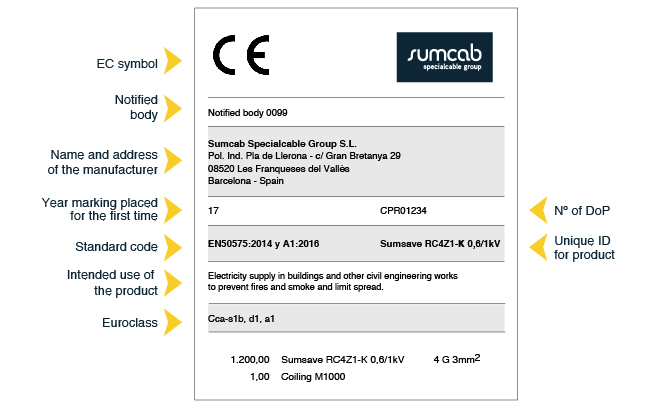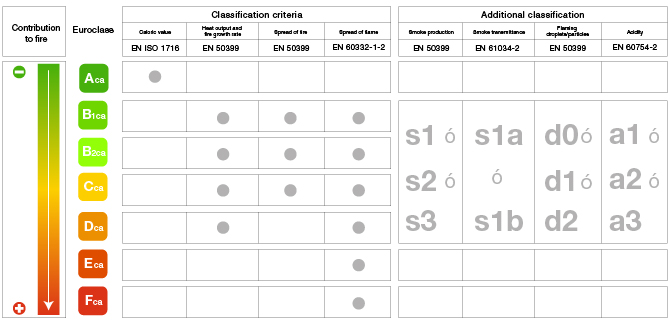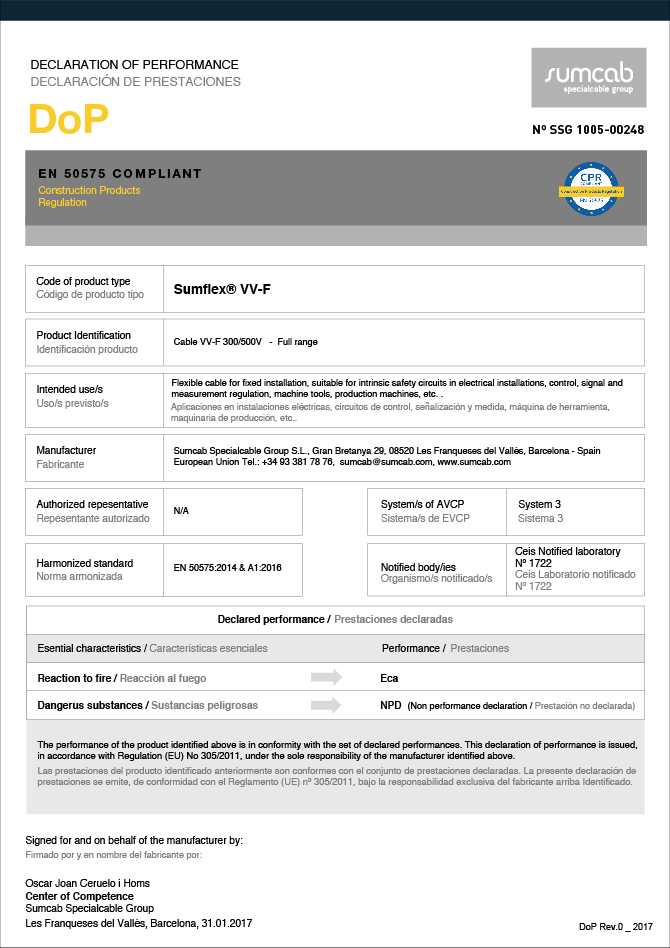-
CPR Information
What is CPR?
CPR = Construction Products Regulation
(305/2011 – Directive 89/106/EEC) .This regulation establishes the basic requirements that all products intended for construction must meet in the European Union. The CPR specifies seven basic safety requirements that must be met, one of which is safety in fires and that directly affect cables.
In order to apply the CPR, the fundamental standard that defines the performance and requirements that cables must meet against fire is EN 50575. These specifications are also classified in EUROCLASSES and depending on the national legislation, each EU country stipulates which Euroclass must be complied with. In Spain, the CPR applies after the date of the adaptation of the REBT (Low Voltage Electrotechnical Regulation), RSCIEI (Industrial Facility Fire Safety Regulation), and ICT (Common Telecommunications Infrastructure).
The CPR defines a construction product as every product which will be permanently included in construction and civil engineering works.
Therefore, all those connection cables to the feed-in, collective control and switching panels, as well as terminal, device, and/or machine's internal cables are excluded. Cables for elevators, service lifts, tow trucks, cranes, cable tray chains, swinging arms, robots, etc. or any cable designed specifically to be used in industrial processes are also excluded.
The EN 50575 standard also defines the administrative and legislative aspects necessary for the manufacturer to demonstrate compliance with the requirements and to market their products. The regulations therefore include three fundamental aspects for monitoring and verifying compliance with it:
AVCP (Assessment and Verification of Constancy of Performance)
The cable's compliance with the manufacturer-stated performance must be demonstrated through assessing and verifying constancy of performance. The manufacturer should always maintain overall control and use all the means to assume responsibility for the product.

EC (EC marking)
The EC marking symbol should be placed visibly, legibly, and permanently on boxes, coiling, retractable items, etc. The marking's symbol should not be on the cable’s sheath.

What are the Euroclasses and additional classifications?
The cables are classified by their performance in terms of their reaction to fire and the emission of hazardous substances. The European Union has created common criteria to define cable fire reaction performance. For this reason, Euroclasses and additional classifications have been defined.

-
Downloads DOP
DoP (Declaration of Performance)
The manufacturer must draw up a Declaration of Performance (DoP). This document identifies the product, what it is to be used for, and the cable's performance in relation to fire safety and the emission of hazardous substances (for the time being this is not assessed since there is no harmonised technical specification). The DoP provides full and documented traceability that all processes and materials used comply with the regulation.
DOP number Sort descending Code of product type Product identification File SSG 2120 U/UTP 4x2x23AWG (0,54) Cat6 350MHz LS0H Cable U/UTP 4x2x23AWG (0,54) Cat6 350MHz LS0H. All range. SSG 2121 F/UTP 4x2x23AWG (0,54) Cat6 350MHz LS0H Cable F/UTP 4x2x23AWG (0,54) Cat6 350MHz LS0H. All range. SSG 2718-01283 Sumsave® AL RHZ1-OL 26/45 kV Cable Sumsave® AL RHZ1-OL 26/45 kV
Range: 1x240mm² to 1x500mm² (57,00mmØ to 83,75mmØ)
SSG 3401 Sumsave® H1Z2Z2-K Cable H1Z2Z2-K 0,6/1kV. Range: 1x1,5mm² to 1x240mm² SSG 4010 Sumline® H07V-U Cable H07V-U 450/750V. Range: From 3,00mmØ to 38,20mmØ SSG 4101 Sumflex® H05VV-F Cable H05VV-F 300/500V. Range: 2x0,75 to 5G4 (6,04mmØ to 17,21mmØ) 
CPR
